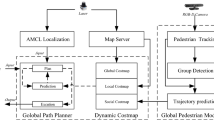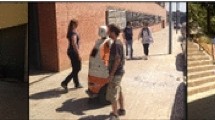Abstract
Based on the human–robot interaction behavior of mobile robots in social navigation, this paper proposes a social navigation quality evaluation model based on combined weights for the problems of single indicators, rough quantification and non-convergence of information in social navigation quality evaluation. Firstly, three evaluation modules of comfort, naturalness and sociality are designed, and each module is refined into primary and secondary indicators. The robot path navigation data are calculated by the indicator quantification formula. Secondly, the subjective and objective weights of hierarchical analysis method and the entropy weight method are combined to determine the index weights at each level. The weighted sum is used to achieve the fusion of index information and obtain the optimal solution of the evaluation navigation algorithm. Finally, we simulate the social scene through visualization simulation experiments to obtain the trajectory data of the robot in the social scene. The experimental results verify the feasibility of the theoretical model and give the final scores and optimization opinions of the tested algorithms. Through the evaluation of the social navigation quality evaluation model, the path planning algorithm that best suits the comfort perception of pedestrians in the current scenario can be found in the tested algorithms.







Similar content being viewed by others
Data availability
The data that support the findings of this study are not openly available due to reasons of sensitivity and are available from the corresponding author upon reasonable request. The data are stored in controlled access data storage at Shandong University.
References
Kruse T, Pandey AK, Alami R et al (2013) Human-aware robot navigation: a survey. Robot Auton Syst 61(12):1726–1743
Fong T, Nourbakhsh I, Dauten-hahn K (2003) A survey of socially interactive robots. Robot Auton Syst 42(3/4):143–166
Charalampous K, Kostavelis I, Gasteratos A (2017) Recent trends in social aware robot navigation: a survey. Robot Auton Syst 93:85–104
Guillén-Ruiz S, Bandera JP, Hidalgo-Paniagua A (2023) A evolution of socially-aware robot navigation. Electronics 12:1570
Helbing D, Molnar P (1995) Social force model for pedestrian dynamics. Phys Rev E 51(5):4282
Van den Berg J, Lin M, Manocha D (2008). Recipro-cal velocity obstacles for real-time multi-agent navigation. IEEE international conference on robotics and automation. piscataway, USA:IEEE. p 1928–1935
Trautman P, Krause A (2010). Unfreezing the robot: Navigation in dense interacting crowds. IEEE/RSJ International Conference on Intelligent Robots and Systems. Piscataway, USA:IEEE, p 797–803
Svenstrup M, Bak T, Andersen H J (2010). Trajectory planning for robots in dynamic human environments. IEEE/RSJ International Conference on Intelligent Robots and Systems. Piscataway, USA:IEEE, p 4293–4298
Wang J, Chan W P, Carreno Medrano P et al. (2022), Metrics for evaluating social conformity of crowd navigation algorithms. 2022 IEEE International conference on advanced robotics and its social impacts (ARSO), Long Beach, CA, USA p 1–6
Biswas A, Wang A, Silvera G et al (2022) Socnavbench: a grounded simulation testing framework for evaluating social navigation. ACM Trans Hum Robot Interact 11(3):1–24
Niu D, Wu G, Ji Z et al (2021) Evaluation of provincial carbon neutrality capacity of China based on combined weight and improved TOPSIS model. Sustainability 13(5):2777
Hall ET (1991) The hidden dimension: man’s use of space in public and private. Behav Sci 36(4):298–310
Truong XT, Ngo TD (2017) Toward socially aware robot navigation in dynamic and crowded environments: a proactive social motion model. IEEE Trans Autom Sci Eng 14(4):1743–1760
Chen YF, Everett M, Liu M et al. (2017) Socially aware motion planning with deep reinforcement learning. 2017 IEEE/RSJ International Conference on Intelligent Robots and Systems (IROS), Vancouver, BC, Canada. p 1343–1350
Acknowledgements
This work was supported by the following projects: National Natural Science Foundation of China 61973192, U1813215, 61973187 and 91748115.
Author information
Authors and Affiliations
Corresponding author
Additional information
Publisher's Note
Springer Nature remains neutral with regard to jurisdictional claims in published maps and institutional affiliations.
About this article
Cite this article
Wu, H., Liu, H. & Wang, K. Design of social navigation quality evaluation model based on combined weight. Artif Life Robotics 28, 726–733 (2023). https://doi.org/10.1007/s10015-023-00894-8
Received:
Accepted:
Published:
Issue Date:
DOI: https://doi.org/10.1007/s10015-023-00894-8




